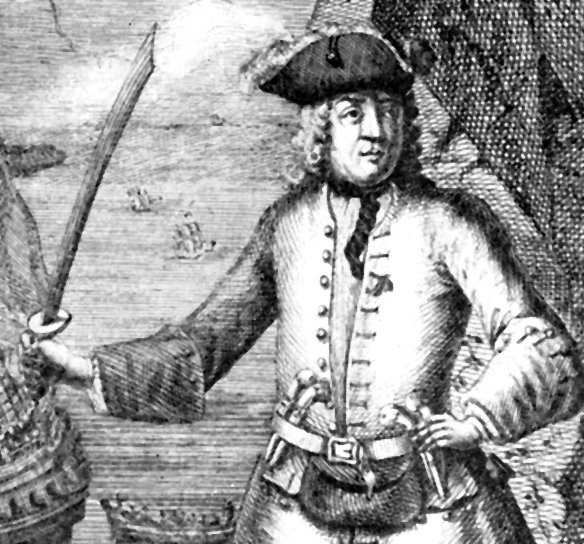
Every Chasing the Great Mughal Ship – The Sea (1887)
Seeing great potential in the Indian fleet, Henry Every and five other pirate captains conspire to attack the convoy heading to Mocha and loot the treasure ship Ganj-i-Sawai. One by one, they pick off parts of the Indian fleet with ease until they reach the Ganj-i-Sawai and its escort, defeating and taking up to £600,000 in gold and silver – the biggest haul ever seized by pirates. Naturally, the Mughal Emperor Aurangzeb is not happy. He blames the British for their countrymen’s actions and holds the EIC personally responsible. Four of the company’s factories are attacked and taken by the emperor. So, to mollify the ruler, a £1,000 bounty is placed on Every’s head and he is made exempt from any possible royal pardon or amnesty.
English mutineer and pirate, last seen at New Providence in the Bahamas. Every—whose name has sometimes been erroneously rendered as ‘‘John Avery,’’ or even ‘‘Long Ben’’—was apparently born to John and Anne ‘‘Evarie’’ in the village of Newton Ferrers, a few miles southeast of Plymouth, England, in August 1659.
The details of his early career are unknown, until he enters the books of the 64-gun HMS Rupert as an experienced mid- shipman under Captain Francis Wheeler in March 1689. In all likelihood, Every must have taken part in the capture of a large French convoy off Brest that summer, the first year of the War of the League of Augsburg or King William’s War, and at the end of July was promoted as chief mate to Rupert’s sailing master. In June 1690, Every transferred to HMS Albemarle of 90 guns when Wheeler became its commander, doubtless seeing action in the disastrous Battle of Beachy Head two weeks later. In August of that same year, Every was discharged from the Royal Navy.
He next appears in 1693, as the mate aboard the heavily-armed private frigate Charles II, which was lying at Grave- send in anticipation of making a salving expedition to the West Indies. An Irish officer named Arthur O’Byrne, after long service in the Royal Spanish Navy, had secured permission from King Charles II of Spain to work wrecks in the Americas. O’Byrne then sought financial and technical support in Lon- don, as England and Spain were temporarily allied against France. The command of this flagship, named in honor of the Spanish monarch and flying his colors, was held by John Strong, who had served with Sir William Phips in a highly lucrative operation on the treasure-ship Concepcion on six years previously.
This latest expedition was also intended to attack French possessions and trade with Spanish-American ports, so was to sail well-armed. In addition to the flagship, there were the frigates James and Dove, as well as the pink Seventh Son. After lengthy delays, this flotilla put into the Spanish port of La Coruna early in 1694, only to remain at anchor for another three months. Strong died, and was succeeded as Flag-Captain by Charles Gibson, with Every as first mate. The English crews grew restless at being thus long unpaid, so that at nine o’clock on a Monday night, May 7, 1694, with Every acting as ringleader, they rose with their flag- ship and slipped past the harbor batteries. Next morning, he set Captain Gibson and some 16 loyal hands adrift in a boat, saying: ‘‘I am a man of fortune, and must seek my fortune.’’ Every then convened a meeting of the 85 mutineers left aboard Charles II, whom he persuaded to embark on a piratical cruise into the Indian Ocean (perhaps in emulation of the well-known exploit of the Rhode Island freebooter Thomas Tew, of that same year). The ship was renamed Fancy, and fell down the West African coast to round the Cape of Good Hope. After a year-and-a-half of adventures in the Far East, Every succeeded in boarding the enormous Mogul trader Ganj-i-sawai off Bombay on September 8, 1695, pillaging it of the immense sum of £200,000.
He and his men then sought a means of escaping with their ill-gotten booty, by returning into the Atlantic, and making for the West Indies. In late April 1696, the weather-beaten Fancy dropped anchor at Royal Island off Eleuthera, some 50 miles from New Providence (modern Nassau) in the Bahamas. Every sent a boat with four men to call on the corrupt local Governor, Nicholas Trott, ostensibly giving his name as ‘‘Henry Bridgeman’’ and alleging that his ship was an ‘‘interloper’’ or unlicensed slaver come from the Guinea Coast with ivory and slaves. Privately, this official was offered a bribe of £1,000 to allow the vessel into port and the pirates to disperse. He signaled his acceptance and Every quickly sailed Fancy into harbor, where he and the Governor furthermore struck a deal as to the disposal of the craft itself. Still maintaining the fiction that this was a legal transaction, Every made the ship over into the Governor’s safe-keeping, ‘‘to take care of her for use of the owners.’’ Once this deal was struck, Fancy was stripped of everything of value—46 guns, 100 barrels of powder, many small arms, 50 tons of ivory, sails, blocks, etc.—and allowed to drift ashore two days later, to be destroyed by the surf.
With this tell-tale piece of evidence obliterated, Every and the majority of his followers disappeared from the Bahamas aboard different passing ships, hoping to blend back into civilian life. He was one of the few rovers who ever fully succeeded in eluding justice, which may be why so many myths have attached themselves to his name, both during his lifetime and since. More typical, perhaps, was his crewman Joseph Morris, left behind on the Bahamas when he went mad after ‘‘losing all his jewels upon a wager.’’
Reference
Baer, Joel H., ‘‘‘Captain John Avery’ and the Anatomy of a Mutiny,’’ Eighteenth-Century Life 18 (February 1994), pp. 1#23.